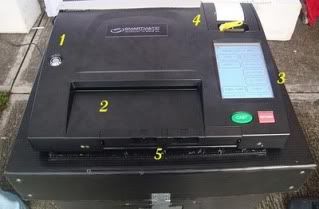
Hours before Tagon-ons went out of their homes to try their hands at the PCOS machine for the May 2010 elections, heaven was already leaking like hell. Still they went to their designated polling places by braving the heavy rains and queued for at least two hours while standing on murky, knee-deep waters.
When rains continued without let-up and people began going home with nary a blot of indelible ink on their index finger, candidates panicked: These people had already received “tili-tili,” what if, because of the hassle that comes with voting, they would just decide to stay at home and not vote?
The Comelec Report
For Tago, COMELEC reported 35 clustered precincts, 21,254 registered voters and 16,638 who actually voted. All these data say is that for every 10 Tagon-on voters, about eight had cast their ballot. Given the inclement weather on May 10, the 78.28% voter turnout is quite high and all because the electorates were curious about the PCOS machine and the new way of voting.
The mayoral race posted the lowest ballot spoilage at 3.29%, trailed by the congressional race at 4.37%. The vice-gubernatorial race posted the highest ballot spoilage at 15.84% followed by the vice-mayoral race at 10.19%.
A little digression: Under automated elections, the PCOS machine rejects the ballot in whole when the bar code is corrupted, the ballot’s crumpled, or the ink has bled. It rejects the ballot in part when a voter over-votes, meaning, instead of voting for only one candidate---as in the case of Mayor---he votes for two or three candidates. Should this happen, only the vote cast for Mayor gets voided while the rest of the entries in the ballot, assuming they’re correct, will be counted.
Moving on now. Spoiled votes in the mayoral and vice-mayoral races amount to 547 and 1,695. This 1,145 disparity reveals that more people erred in shading the name of their vice mayor than their mayor. Or that they had over-voted. What is interesting is that the chance of accidentally over-voting in the vice mayoral race was slim as it contained only two names and written in one line because of the “landscape” orientation of the ballot. Compare this with the mayoral race which had three names and written in two lines.
Could it be that some electorates voted for mayor but not for vice mayor?
The Tagon-ons, the Ballot and the PCOS Machine
Most Tagon-ons, including moi, hadn’t attended a PCOS briefing that Comelec conducted in all barangays and so they didn’t know that automation involved only canvassing and transmission but not filling out of ballots. And when Comelec conducted a mock election to test the PCOS machine days before May 10, this fear spiraled because almost all the participants said the special marker had the tendency to bleed out of the provided “itlog” that preceded the names of the candidates, and that their ballots were repeatedly rejected before the PCOS machine finally swallowed it.
Candidates gave out “tili-tili” stapled to a sample ballot that contained their name and their corresponding “itlog” and number in bigger and bolder print. The official ballot however had the names, “itlog,” and number written in smaller font and fading ink. And if one wasn’t careful enough, the ink would really bleed and taint the other “itlog,” thus spoiling that portion of the ballot.
Negotiating the ballot was particularly hard for senior citizens, what with their failing eyesight and shaking hands. Next time around, it’s best for them to request for assistance to save them a lot of trouble.
There was a sense of hesitation and palpable fear every time a voter approached the PCOS machine to feed his ballot. It just didn’t help that a teacher was around, ready to assist. But when the machine ate the ballot, the voter’s face lit up as though he were a cell phone receiving a text message.
Cold and dark, the PCOS machine inspired techno fear, especially for voters living under the rocks. But some decided to confront this fear by opting to feed the ballots themselves despite racing hearts and unsteady hands. Their reward came in seeing the word “Congratulations” blinking on the small screen!
Lessons Learned
Tagon-ons have realized that with automation, they could indeed vote for their choices and never be discovered, unlike before where “contra-senyas” tended to unmask them. They have also discovered that it’s now easier to vote as they only have to shade the “itlog” rather than write the names on the ballot and that it’s easier to remember the candidates with their assigned numbers than by their names.
Tagon-ons have also realized that it’s now quicker to canvass votes than before because by midnight, the winners were already known.

No comments:
Post a Comment